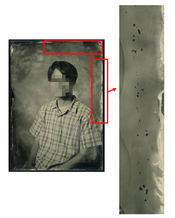This is an ambrotype (5x7 inches) I shot today. It looks like the collodion has flaked away in small spots here and there, especially around the edges of the plate. What do you think could be the cause?
The room temperature was quite high at 28°C, which resulted in a lot of fogging, and when I wiped the plate during the water rinse with cotton, it might have caused some of the flaking, but I only noticed it after everything had dried. It happened before but I couldn't find the cause when that happened.
Anyways it’s possible that I waited too much time after applying the collodion and submerging the plate in the silver bath (about 50 seconds), causing the collodion to dry from the edges, but I’m still not sure of the exact cause.
If you have any suggestions or hints that might help solve this, I would appreciate it!!
Many thanks!
The room temperature was quite high at 28°C, which resulted in a lot of fogging, and when I wiped the plate during the water rinse with cotton, it might have caused some of the flaking, but I only noticed it after everything had dried. It happened before but I couldn't find the cause when that happened.
Anyways it’s possible that I waited too much time after applying the collodion and submerging the plate in the silver bath (about 50 seconds), causing the collodion to dry from the edges, but I’m still not sure of the exact cause.
If you have any suggestions or hints that might help solve this, I would appreciate it!!
Many thanks!



